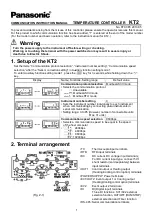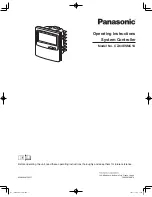
Page 17
©
2017 Sensata Technologies
Installation
2.5 PV Voltage Requirements
Proper array sizing is crucial to ensure the maximum power output of the PV array is within the PT
controller’s MPPT voltage range during normal operating conditions, and to ensure the PV voltage
does not exceed the PT-100’s maximum input voltage limit—to prevent damage to the PT-100.
Changes in environmental conditions, such as solar irradiance and ambient temperature, affect
the PV array’s voltage and current output, and need to be considered when sizing and wiring the
array to work with the PT-100 controller.
A PV module’s output voltage is mainly affected by temperature (and to a lesser degree by solar
irradiation). When temperatures decrease, the module’s output voltage increases. The panel
manufacturer usually lists a negative temperature coef
fi
cient rating that provides the amount of
voltage change, some are listed in negative mV per degree Celsius (-mV/°C) and others are listed
as a negative percentage per degree Celsius (-%/°C). These negative temperature coef
fi
cients mean
that for every 1°C change in temperature, the module’s output voltage will change in the opposite
direction. The panel manufacturer provides a V
OC
and V
MP
rating per panel, but they are normally
rated at 25°C. The voltage change coef
fi
cient for the V
OC
and V
MP
are different. They both need to
be calculated to ensure they meet the requirements of the controller, and to determine how many
PV modules to connect in series.
Info:
Excellent resources for local weather information can be found at: www.weather.
com and www.weatherbase.com.
Info:
The negative sign in front of the temperature coef
fi
cient rating indicates a negative
correlation coef
fi
cient, meaning the two variables are in an inverse relationship. For PV
modules, as the temperature goes down, the module voltage increases.
2.5.1
PV Input Voltage Limits for the PT-100
The following PV voltage levels are required for the PT-100 controller to operate (refer to Table
2-1 and also see Figure 4-8):
• PV Array’s Lower Maximum Power Voltage (V
MP-LOW
)
Level
– The PV array should be
designed to ensure the Maximum Power Voltage (V
MP
) of the PV array string—at the highest
average ambient temperature—does not normally operate below the lower level of the MMPT
voltage range to deliver the optimal energy to the batteries.
• PV Array’s Upper Output Voltage (V
OC-UPP
) Level
– The PV array should be designed to
ensure the Open Circuit Voltage (V
OC
) of the PV array string - at the lowest average ambient
temperature—does not normally operate above the upper level of the MMPT voltage range of
the PT-100 to prevent the PT-100 from unnecessarily shutting down.
Note:
The PT-100 will shut down if within the High V
OC
Range, but damage will not occur.
• PV Array’s Maximum Output Voltage (V
OC-MAX
)
Level
– The PV array should be designed
to ensure the Open Circuit Voltage (V
OC
) of the PV array string - at the lowest expected
ambient temperature—should never exceed the maximum PV input voltage level of the PT-
100 to avoid damaging the controller.
Table 2-1, PV Input Voltage Parameters
Nominal
Battery
Voltage
Operating
Range (V
OC
)
MPPT
Range (V
MP
)
High V
OC
Range
(PT shuts down*)
Max PV Input
Voltage Level
(damage can occur)
12V
24V to 187V
60V to 187V
188V* to 210V
211V or higher
24V
40V to 187V
50V to 187V
188V* to 220V
221V or higher
48V
72V to 187V
77V to 187V
188V* to 240V
241V or higher
CAUTION:
Under any condition, ensure the array’s V
OC
is kept below the Max PV Input
Voltage level. PV voltage at or above this level has a high probably of causing damage to
the PT-100.
















































